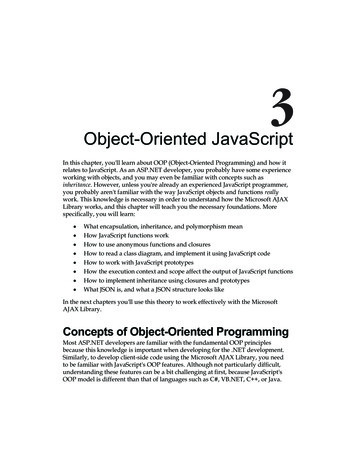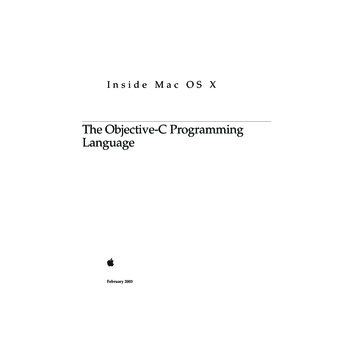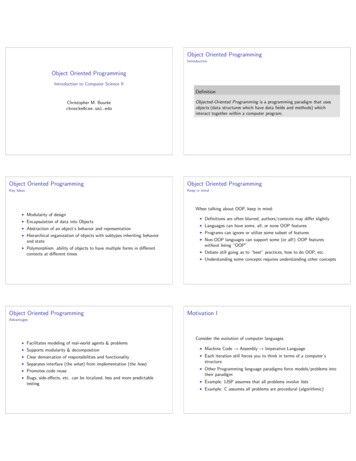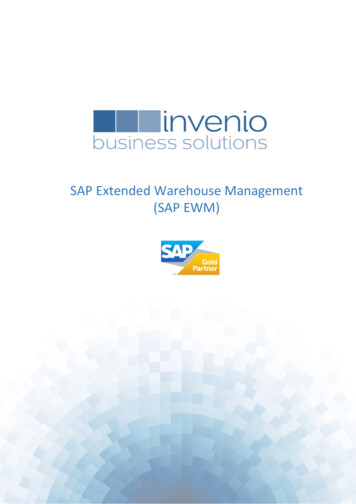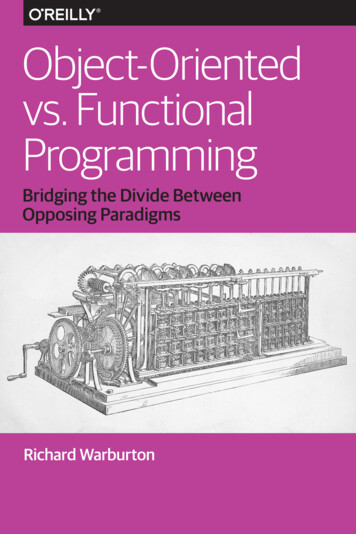
Transcription
Object-Orientedvs. FunctionalProgrammingBridging the Divide BetweenOpposing ParadigmsRichard Warburton
Object-Oriented vs.Functional ProgrammingBridging the Divide BetweenOpposing ParadigmsRichard Warburton
Object-Oriented vs. Functional Programmingby Richard WarburtonCopyright 2016 O’Reilly Media. All rights reserved.Printed in the United States of America.Published by O’Reilly Media, Inc., 1005 Gravenstein Highway North, Sebastopol, CA95472.O’Reilly books may be purchased for educational, business, or sales promotional use.Online editions are also available for most titles (http://safaribooksonline.com). Formore information, contact our corporate/institutional sales department:800-998-9938 or corporate@oreilly.com .Editor: Brian FosterProduction Editor: Nicholas AdamsCopyeditor: Amanda KerseyProofreader: Nicholas AdamsNovember 2015:Interior Designer: David FutatoCover Designer: Randy ComerIllustrator: Rebecca DemarestFirst EditionRevision History for the First Edition2015-10-30:First ReleaseWhile the publisher and the author have used good faith efforts to ensure that theinformation and instructions contained in this work are accurate, the publisher andthe author disclaim all responsibility for errors or omissions, including without limi‐tation responsibility for damages resulting from the use of or reliance on this work.Use of the information and instructions contained in this work is at your own risk. Ifany code samples or other technology this work contains or describes is subject toopen source licenses or the intellectual property rights of others, it is your responsi‐bility to ensure that your use thereof complies with such licenses and/or rights.978-1-491-93342-8[LSI]
Table of ContentsIntroduction. . . . . . . . . . . . . . . . . . . . . . . . . . . . . . . . . . . . . . . . . . . . . . . vii1. Lambdas: Parameterizing Code by Behavior. . . . . . . . . . . . . . . . . . . . . 1Why Do I Need to Learn About Lambda Expressions?The Basics of Lambda ExpressionsSummary1252. SOLID Principles. . . . . . . . . . . . . . . . . . . . . . . . . . . . . . . . . . . . . . . . . . . . . 7Lambda-Enabled SOLID PrinciplesThe Single-Responsibility PrincipleThe Open/Closed PrincipleThe Liskov Substitution PrincipleThe Interface-Segregation PrincipleThe Dependency-Inversion PrincipleSummary7710141517213. Design Patterns. . . . . . . . . . . . . . . . . . . . . . . . . . . . . . . . . . . . . . . . . . . . 23Functional Design PatternsThe Command PatternStrategy PatternSummary232328314. Conclusions. . . . . . . . . . . . . . . . . . . . . . . . . . . . . . . . . . . . . . . . . . . . . . . . 33Object-Oriented vs. Functional LanguagesProgramming Language Evolution3334v
IntroductionOne of my favorite professional activities is speaking at softwareconferences. It’s great fun because you get to meet developers whoare passionate about their craft, and it gives you as a speaker theopportunity to share knowledge with them.A talk that I’ve enjoyed giving recently is called “Twins: FP andOOP.” I’ve given it at a number of conferences and user group ses‐sions, and I’ve even had the pleasure of giving it as O’Reilly webcast.Developers enjoy the talk both because it has a large number of ref‐erences to the film “Twins” and because it discusses one of the ageold relationships between functional and object-oriented program‐ming.There’s only so much you can say in a conference talk though, so Iwas really excited when Brian Foster from O’Reilly contacted me toask if I wanted to expand upon the topic in a report. You can alsothink of this as a short followup to my earlier O’Reilly publishedbook Java 8 Lambdas (O’Reilly).You can watch the talk delivered at a conference online or deliveredas an O’Reilly webcast.What Object-Oriented and FunctionalProgrammers Can Learn From Each OtherBefore we get into the technical nitty-gritty of lambdas and designpatterns, let’s take a look at the technical communities. This willexplain why comparing the relationship between functional andobject-oriented is so important and relevant.vii
If you’ve ever read Hacker News, a programming subreddit, or anyother online forum, you might have noticed there’s often a touch offriction between functional programmers and developers practicingthe object-oriented style. They often sound like they’re talking in adifferent language to each other, sometimes even going so far as tothrow the odd snarky insult around.On the one hand, functional programmers can often look down ontheir OO counterparts. Functional programs can be very terse andelegant, packing a lot of behavior into very few lines of code. Func‐tional programmers will make the case that in a multicore world,you need to avoid mutable state in order to scale out your programs,that programming is basically just math, and that now is the time foreveryone to think in terms of functions.Object-oriented programmers will retort that in actual businessenvironments, very few programmers use functional languages.Object-oriented programming scales out well in terms of develop‐ers, and as an industry, we know how to do it. While programmingcan be viewed as a discipline of applied math, software engineeringrequires us to match technical solutions to business problems. Thedomain modelling and focus on representing real-world objects thatOOP encourages in developers helps narrow that gap.Of course, these stereotypes are overplaying the difference. Bothgroups of programmers are employed to solve similar businessproblems. Both groups are working in the same industry. Are theyreally so different?I don’t think so, and I think there’s a lot that we can learn from eachother.What’s in This ReportThis report makes the case that a lot of the constructs of goodobject-oriented design also exist in functional programming. Inorder to make sure that we’re all on the same page, Chapter 1explains a little bit about functional programming and the basics oflambda expressions in Java 8.In Chapter 2, we take a look at the SOLID principles, identified byRobert Martin, and see how they map to functional languages andparadigms. This demonstrates the similarity in terms of higher-levelconcepts.viii Introduction
In Chapter 3, we look at some behavioral design patterns. Designpatterns are commonly used as a vocabulary of shared knowledgeamongst object-oriented programmers. They’re also often criticizedby functional programmers. Here we’ll look at how some of themost common object-oriented design patterns exist in the func‐tional world.Most of the examples in this guide are written in the Java program‐ming language. That’s not to say that Java is the only language thatcould have been used or that it’s even a good one! It is perfectly ade‐quate for this task though and understood by many people. Thisguide is also motivated by the release of Java 8 and its introductionof lambda expressions to the language. Having said all that, a lot ofprinciples and concepts apply to many other programming lan‐guages as well, and I hope that whatever your programming lan‐guage is, you take something away.Introduction ix
CHAPTER 1Lambdas: Parameterizing Code byBehaviorWhy Do I Need to Learn About LambdaExpressions?Over the next two chapters, we’re going to be talking in depth aboutthe relationship between functional and object-oriented program‐ming principles, but first let’s cover some of the basics. We’re goingto talk about a couple of the key language features that are related tofunctional programming: lambda expressions and method refer‐ences.If you already have a background in functional pro‐gramming, then you might want to skip this chapterand move along to the next one.We’re also going to talk about the change in thinking that theyenable which is key to functional thinking: parameterizing code bybehavior. It’s this thinking in terms of functions and parameterizingby behavior rather than state which is key to differentiating func‐tional programming from object-oriented programming. Theoreti‐cally this is something that we could have done in Java before withanonymous classes, but it was rarely done because they were sobulky and verbose.1
We shall also be looking at the syntax of lambda expressions in theJava programming language. As I mentioned in the Introduction, alot of these ideas go beyond Java; we are just using Java as a linguafranca: a common language that many developers know well.The Basics of Lambda ExpressionsWe will define a lambda expression as a concise way of describing ananonymous function. I appreciate that’s quite a lot to take in at once,so we’re going to explain what lambda expressions are by workingthrough an example of some existing Java code. Swing is a platformagnostic Java library for writing graphical user interfaces (GUIs). Ithas a fairly common idiom in which, in order to find out what youruser did, you register an event listener. The event listener can thenperform some action in response to the user input (seeExample 1-1).Example 1-1. Using an anonymous inner class to associate behaviorwith a button clickbutton.addActionListener(new ActionListener() {public void actionPerformed(ActionEvent event) {System.out.println("button clicked");}});In this example, we’re creating a new object that provides an imple‐mentation of the ActionListener class. This interface has a singlemethod, actionPerformed, which is called by the button instancewhen a user actually clicks the on-screen button. The anonymousinner class provides the implementation of this method. InExample 1-1, all it does is print out a message to say that the buttonhas been clicked.This is actually an example of behavior parameteriza‐tion—we’re giving the button an object that representsan action.Anonymous inner classes were designed to make it easier for Javaprogrammers to represent and pass around behaviors. Unfortu‐nately, they don’t make it easy enough. There are still four lines of2 Chapter 1: Lambdas: Parameterizing Code by Behavior
boilerplate code required in order to call the single line of importantlogic.Boilerplate isn’t the only issue, though: this code is fairly hard toread because it obscures the programmer’s intent. We don’t want topass in an object; what we really want to do is pass in some behavior.In Java 8, we would write this code example as a lambda expression,as shown in Example 1-2.Example 1-2. Using a lambda expression to associate behavior with abutton clickbutton.addActionListener(event - System.out.println("button clicked"));Instead of passing in an object that implements an interface, we’repassing in a block of code—a function without a name. event is thename of a parameter, the same parameter as in the anonymousinner class example. - separates the parameter from the body of thelambda expression, which is just some code that is run when a userclicks our button.Another difference between this example and the anonymous innerclass is how we declare the variable event. Previously, we needed toexplicitly provide its type—ActionEvent event. In this example, wehaven’t provided the type at all, yet this example still compiles. Whatis happening under the hood is that javac is inferring the type of thevariable event from its context—here, from the signature ofaddActionListener. What this means is that you don’t need toexplicitly write out the type when it’s obvious. We’ll cover this infer‐ence in more detail soon, but first let’s take a look at the differentways we can write lambda expressions.Although lambda method parameters require less boil‐erplate code than was needed previously, they are stillstatically typed. For the sake of readability and famili‐arity, you have the option to include the type declara‐tions, and sometimes the compiler just can’t work itout!Method ReferencesA common idiom you may have noticed is the creation of a lambdaexpression that calls a method on its parameter. If we want a lambdaThe Basics of Lambda Expressions 3
expression that gets the name of an artist, we would write the fol‐lowing:artist - artist.getName()This is such a common idiom that there’s actually an abbreviatedsyntax for this that lets you reuse an existing method, called amethod reference. If we were to write the previous lambda expressionusing a method reference, it would look like this:Artist::getNameThe standard form is Classname::methodName. Remember that eventhough it’s a method, you don’t need to use brackets because you’renot actually calling the method. You’re providing the equivalent of alambda expression that can be called in order to call the method.You can use method references in the same places as lambda expres‐sions.You can also call constructors using the same abbreviated syntax. Ifyou were to use a lambda expression to create an Artist, you mightwrite:(name, nationality) - new Artist(name, nationality)We can also write this using method references:Artist::newThis code is not only shorter but also a lot easier to read.Artist::new immediately tells you that you’re creating a newArtist without your having to scan the whole line of code. Anotherthing to notice here is that method references automatically supportmultiple parameters, as long as you have the right functional inter‐face.It’s also possible to create arrays using this method. Here is how youwould create a String array:String[]::newWhen we were first exploring the Java 8 changes, a friend of minesaid that method references “feel like cheating.” What he meant wasthat, having looked at how we can use lambda expressions to pass4 Chapter 1: Lambdas: Parameterizing Code by Behavior
code around as if it were data, it felt like cheating to be able to refer‐ence a method directly.In fact, method references are really making the concept of firstclass functions explicit. This is the idea that we can pass behavioraround and treat it like another value. For example, we can composefunctions together.SummaryWell, at one level we’ve learnt a little bit of new syntax that has beenintroduced in Java 8, which reduces boilerplate for callbacks andevent handlers. But actually there’s a bigger picture to these changes.We can now reduce the boilerplate around passing blocks of behav‐ior: we’re treating functions as first-class citizens. This makesparameterizing code by behavior a lot more attractive. This is key tofunctional programming, so key in fact that it has an associatedname: higher-order functions.Higher-order functions are just functions, methods, that returnother functions or take functions as a parameter. In the next chapterwe’ll see that a lot of design principles in object-oriented program‐ming can be simplified by the adoption of functional concepts likehigher-order functions. Then we’ll look at how many of the behavio‐ral design patterns are actually doing a similar job to higher-orderfunctions.Summary 5
CHAPTER 2SOLID PrinciplesLambda-Enabled SOLID PrinciplesThe SOLID principles are a set of basic principles for designing OOprograms. The name itself is an acronym, with each of the five prin‐ciples named after one of the letters: Single responsibility, Open/closed, Liskov substitution, Interface segregation, and Dependencyinversion. The principles act as a set of guidelines to help you imple‐ment code that is easy to maintain and extend over time.Each of the principles corresponds to a set of potential code smellsthat can exist in your code, and they offer a route out of the prob‐lems caused. Many books have been written on this topic, and I’mnot going to cover the principles in comprehensive detail.In the case of all these object-oriented principles, I’ve tried to find aconceptually related approach from the functional-programmingrealm. The goal here is to both show functional and object-orientedprogramming are related, and also what object-oriented program‐mers can learn from a functional style.The Single-Responsibility PrincipleEvery class or method in your program should have only a single rea‐son to change.An inevitable fact of software development is that requirementschange over time. Whether because a new feature needs to be added,your understanding of your problem domain or customer has7
changed, or you need your application to be faster, over time soft‐ware must evolve.When the requirements of your software change, the responsibilitiesof the classes and methods that implement these requirements alsochange. If you have a class that has more than one responsibility,when a responsibility changes, the resulting code changes can affectthe other responsibilities that the class possesses. This possiblyintroduces bugs and also impedes the ability of the code base toevolve.Let’s consider a simple example program that generates a BalanceSheet. The program needs to tabulate the BalanceSheet from a listof assets and render the BalanceSheet to a PDF report. If the imple‐menter chose to put both the responsibilities of tabulation and ren‐dering into one class, then that class would have two reasons forchange. You might wish to change the rendering in order to gener‐ate an alternative output, such as HTML. You might also wish tochange the level of detail in the BalanceSheet itself. This is a goodmotivation to decompose this problem at the high level into twoclasses: one to tabulate the BalanceSheet and one to render it.The single-responsibility principle is stronger than that, though. Aclass should not just have a single responsibility: it should alsoencapsulate it. In other words, if I want to change the output format,then I should have to look at only the rendering class and not at thetabulation class.This is part of the idea of a design exhibiting strong cohesion. A classis cohesive if its methods and fields should be treated togetherbecause they are closely related. If you tried to divide up a cohesiveclass, you would result in accidentally coupling the classes that youhave just created.Now that you’re familiar with the single-responsibility principle, thequestion arises, what does this have to do with lambda expressions?Well lambda expressions make it a lot easier to implement thesingle-responsibility principle at the method level. Let’s take a lookat some code that counts the number of prime numbers up to a cer‐tain value (Example 2-1).8 Chapter 2: SOLID Principles
Example 2-1. Counting prime numbers with multiple responsibilitiesin a methodpublic long countPrimes(int upTo) {long tally 0;for (int i 1; i upTo; i ) {boolean isPrime true;for (int j 2; j i; j ) {if (i % j 0) {isPrime false;}}if (isPrime) {tally ;}}return tally;}It’s pretty obvious that we’re really doing two different responsibili‐ties in Example 2-1: we’re counting numbers with a certain property,and we’re checking whether a number is a prime. As shown inExample 2-2, we can easily refactor this to split apart these tworesponsibilities.Example 2-2. Counting prime numbers after refactoring out theisPrime checkpublic long countPrimes(int upTo) {long tally 0;for (int i 1; i upTo; i ) {if (isPrime(i)) {tally ;}}return tally;}private boolean isPrime(int number) {for (int i 2; i number; i ) {if (number % i 0) {return false;}}return true;}Unfortunately, we’re still left in a situation where our code has tworesponsibilities. For the most part, our code here is dealing withThe Single-Responsibility Principle 9
looping over numbers. If we follow the single-responsibility princi‐ple, then iteration should be encapsulated elsewhere. There’s also agood practical reason to improve this code. If we want to count thenumber of primes for a very large upTo value, then we want to beable to perform this operation in parallel. That’s right—the thread‐ing model is a responsibility of the code!We can refactor our code to use the Java 8 streams library (seeExample 2-3), which delegates the responsibility for controlling theloop to the library itself. Here we use the range method to count thenumbers between 0 and upTo, filter them to check that they reallyare prime, and then count the result.Example 2-3. Counting primes using the Java 8 streams APIpublic long countPrimes(int upTo) {return IntStream.range(1, upTo).filter(this::isPrime).count();}private boolean isPrime(int number) {return IntStream.range(2, number).allMatch(x - (number % x) ! 0);}So, we can use higher-order functions in order to help us easilyimplement the single-responsibility principle.The Open/Closed PrincipleSoftware entities should be open for extension,but closed for modification.—Bertrand MeyerThe overarching goal of the open/closed principle is similar to thatof the single-responsibility principle: to make your software lessbrittle to change. Again, the problem is that a single feature requestor change to your software can ripple through the code base in away that is likely to introduce new bugs. The open/closed principleis an effort to avoid that problem by ensuring that existing classescan be extended without their internal implementation being modi‐fied.10 Chapter 2: SOLID Principles
When you first hear about the open/closed principle, it sounds like abit of a pipe dream. How can you extend the functionality of a classwithout having to change its implementation? The actual answer isthat you rely on an abstraction and can plug in new functionalitythat fits into this abstraction. We can also use higher-order functionsand immutability to achieve similar aims in a functional style.AbstractionRobert Martin’s interpretation of the open/closed principle was thatit was all about using polymorphism to easily depend upon anabstraction. Let’s think through a concrete example. We’re writing asoftware program that measures information about system perfor‐mance and graphs the results of these measurements. For example,we might have a graph that plots how much time the computerspends in user space, kernel space, and performing I/O. I’ll call theclass that has the responsibility for displaying these metricsMetricDataGraph.One way of designing the MetricDataGraph class would be to haveeach of the new metric points pushed into it from the agent thatgathers the data. So, its public API would look something likeExample 2-4.Example 2-4. The MetricDataGraph public APIclass MetricDataGraph {public void updateUserTime(int value);public void updateSystemTime(int value);public void updateIoTime(int value);}But this would mean that every time we wanted to add in a new setof time points to the plot, we would have to modify the MetricDataGraph class. We can resolve this issue by introducing an abstraction,which I’ll call a TimeSeries, that represents a series of points intime. Now our MetricDataGraph API can be simplified to notdepend upon the different types of metric that it needs to display, asshown in Example 2-5.The Open/Closed Principle 11
Example 2-5. Simplified MetricDataGraph APIclass MetricDataGraph {public void addTimeSeries(TimeSeries values);}Each set of metric data can then implement the TimeSeries inter‐face and be plugged in. For example, we might have concrete classescalled UserTimeSeries, SystemTimeSeries, and IoTimeSeries. Ifwe wanted to add, say, the amount of CPU time that gets stolen froma machine if it’s virtualized, then we would add a new implementa‐tion of TimeSeries called StealTimeSeries. MetricDataGraph hasbeen extended but hasn’t been modified.Higher-Order FunctionsHigher-order functions also exhibit the same property of being openfor extension, despite being closed for modification. A good exam‐ple of this is the ThreadLocal class. The ThreadLocal class providesa variable that is special in the sense that each thread has a singlecopy for it to interact with. Its static withInitial method is ahigher-order function that takes a lambda expression that representsa factory for producing an initial value.This implements the open/closed principle because we can get newbehavior out of ThreadLocal without modifying it. We pass in a dif‐ferent factory method to withInitial and get an instance ofThreadLocal with different behavior. For example, we can useThreadLocal to produce a DateFormatter that is thread-safe withthe code in Example 2-6.Example 2-6. A ThreadLocal date formatter// One implementationThreadLocal DateFormat localFormatter ThreadLocal.withInitial(SimpleDateFormat::new);// UsageDateFormat formatter localFormatter.get();12 Chapter 2: SOLID Principles
We can also generate completely different behavior by passing in adifferent lambda expression. For example, in Example 2-7 we’re cre‐ating a unique identifier for each Java thread that is sequential.Example 2-7. A ThreadLocal identifier// Or.AtomicInteger threadId new AtomicInteger();ThreadLocal Integer localId ThreadLocal.withInitial(() - threadId.getAndIncrement());// Usageint idForThisThread localId.get();ImmutabilityAnother interpretation of the open/closed principle that doesn’t fol‐low in the object-oriented vein is the idea that immutable objectsimplement the open/closed principle. An immutable object is onethat can’t be modified after it is created.The term “immutability” can have two potential interpretations:observable immutability or implementation immutability. Observableimmutability means that from the perspective of any other object, aclass is immutable; implementation immutability means that theobject never mutates. Implementation immutability implies observ‐able immutability, but the inverse isn’t necessarily true.A good example of a class that proclaims its immutability butactually is only observably immutable is java.lang.String, as itcaches the hash code that it computes the first time its hashCodemethod is called. This is entirely safe from the perspective of otherclasses because there’s no way for them to observe the differencebetween it being computed in the constructor every time or cached.I mention immutable objects in the context of this report becausethey are a fairly familiar concept within functional programming.They naturally fit into the style of programming that I’m talkingabout.Immutable objects implement the open/closed principle in the sensethat because their internal state can’t be modified, it’s safe to add newmethods to them. The new methods can’t alter the internal state ofthe object, so they are closed for modification, but they are addingbehavior, so they are open to extension. Of course, you still need toThe Open/Closed Principle 13
be careful in order to avoid modifying state elsewhere in your pro‐gram.Immutable objects are also of particular interest because they areinherently thread-safe. There is no internal state to mutate, so theycan be shared between different threads.If we reflect on these different approaches, it’s pretty clear that we’vediverged quite a bit from the traditional open/closed principle. Infact, when Bertrand Meyer first introduced the principle, he definedit so that the class itself couldn’t ever be altered after being comple‐ted. Within a modern Agile developer environment, it’s pretty clearthat the idea of a class being complete is fairly outmoded. Businessrequirements and usage of the application may dictate that a class beused for something that it wasn’t intended to be used for. That’s nota reason to ignore the open/closed principle though, just a goodexample of how these principles should be taken as guidelines andheuristics rather than followed religiously or to the extreme. Weshouldn’t judge the original definition too harshly, however, since itused in a different era and for software with specific and definedrequirements.A final point that I think is worth reflecting on is that in the contextof Java 8, interpreting the open/closed principle as advocating anabstraction that we can plug multiple classes into or advocatinghigher-order functions amounts to the same approach. Because ourabstraction needs to be represented by an interface upon whichmethods are called, this approach to the open/closed principle isreally just a usage of polymorphism.In Java 8, any lambda expression that gets passed into a higher-orderfunction is represented by a functional interface. The higher-orderfunction calls its single method, which leads to different behaviordepending upon which lambda expression gets passed in. Again,under the hood, we’re using polymorphism in order to implementthe open/closed principle.The Liskov Substitution PrincipleLet q(x) be a property provable about objects x of type T. Then q(y)should be true for objects y of type S where S is a subtype of T.The Liskov substitution principle is often stated in these very formalterms, but is actually a very simple concept. Informally we can think14 Chapter 2: SOLID Principles
of this as meaning that child classes should maintain the behaviorthey inherit from their parents. We can split out that property intofour distinct areas: Preconditions cannot be strengthened in a subtype. Where theparent worked, the child should. Postconditions cannot be weakened in a subtype. Where theparent caused an effect, then the child should. Invariants of the supertype must be preserved in a subtype.Where parent always stuck left or maintained something, thenthe child should as well. Rule from history: don’t allow state changes that your parentdidn’t. For example, a mutable point can’t subclass an immuta‐ble point.Functional programming tends to take a different perspective toLSP. In functional programming inheritance of behavior isn’t a keytrait. If you avoid inheritance hierachies then you avoid the prob‐lems that are associated with them, which is the antipattern that theLiskov substitution principle is designed to solve. This is actuallybecoming increasing accepted within the object-oriented commu‐nity as well through the composite reuse principle: compose, don’tinherit.The Interface-Segregation PrincipleThe dependency of one class to another one should depend on thesmallest possible interfaceIn order to properly understand the interface-segregation principle,let’s consider a worked example in which w
Object-oriented programmers will retort that in actual business environments, very few programmers use functional languages. Object-oriented programming scales out well in terms of develop‐ ers, and as an industry, we know how to do it. While programming can be viewed as a discipli


